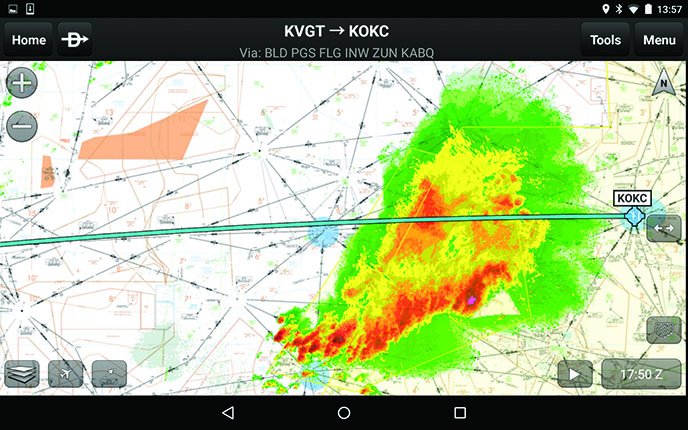One of the concerns many pilots express about doing their flight planning on a tablet computer is that they don’t spend time with a chart and a plotter looking over a route. They end up starting a flight with less situational awareness about airports where they can bail out if something goes wrong en route. That, combined with what can become a rote fixation on selecting an IFR alternate based only on the regs regarding weather at the destination, is an invitation to poor decision-making when a little smoke in the cockpit means shutting off the electrical system a third of the way into the flight, or the engine starts running rough on initial climb from an airport that’s below approach minimums.
One way out of these dilemmas is to keep in mind the FARs are, by law, nothing more than minimum standards—and only looking at an alternate airport for the destination on an IFR flight of 500 miles might not be doing ourselves any favors. We always need an ace in the hole, and it doesn’t have to be the one we tell the FAA about on the flight plan.
En Route
It doesn’t take long to pan along the magenta line in your flight planning app and eyeball the airports that are within 25 miles or so of your course. Many apps have a color-coded display alerting you to the current weather at those that report—a great bit of information to have both prior to departure and while en route. Beyond that, those tools also are valuable for simply getting a feel for what’s available. And paying attention to the terrain along the way can help you understand what challenges might make getting to the runway interesting. While an alternate with food, fuel and maintenance is a great thing, it’s really not as important as departing with full awareness of what’s out there to improve the quality of a diversion decision you may have to make in a hurry.
If we’re in a situation where getting to a legal alternate means having to fly quite a ways, fuel considerations make essential our keeping track of realistic alternatives along the way as we whistle toward where we really want to land. That can mean an intermediate stop to top off the tanks before tackling really hairy weather. After all, aren’t headwinds always stronger than the forecast? It’s either headwinds or ATC won’t give us the altitude we need for a tailwind. It’s not unusual for real winds to make our planned alternate unreachable. A little extra headwind, or maybe the extra drag of some ice picked up on climbout, combined with a dearth of practical alternates in range of our destination may make stopping for fuel the smart decision. And it’s always better to arrive with plenty of gas, rather than mumble “minimum fuel” to ATC.
There are times a routine weather check while en route turns up news that weather at our alternate has gone down the tubes. While weather at our destination may still be superb, it’s still a cause for concern. That’s because destination airports have a funny way of closing when we most need them—a gear-up that slides to a stop at the intersection of the only two runways, snow removal begins, construction materials on the roof of the tower catch fire—they’ve all happened to me. When the back door we’ve been relying on slams shut, it’s time to find another one that we can wedge open. Once again, having plenty of fuel broadens the choices. And don’t forget: you always can just turn around.

Destination Alternates
We know that, per FAR 91.167, we have to have enough fuel to fly to our destination, fly to our declared alternate and then fly for another 45 minutes at normal cruising speed. If we’re smart, we carry more than 45 minutes and/or we plan to spend that time at our full-power, takeoff fuel flow and a normal cruising speed. Why use such a high fuel-burn rate to calculate the fuel required?
If we shoot an approach and miss, that’s what we’ll be burning until we’re back to altitude and motoring off somewhere else at our normal cruise settings. That can take five minutes, or it can take 15. Regardless, at this point, we’re likely not getting into our destination, so Job One is getting on the ground somewhere and regrouping. It never hurts to know that if we do have to burn our reserve fuel we’re going to make it last longer (and increase our range) by cruising—or holding—at a much lower power setting, maybe 45-percent. That easily could give us another 90 minutes where we only had 45. We’ll eat into that margin by cruising more slowly—it will take a bit more time to get on the ground—but we’ll still have some dinosaur juice sloshing around in the tanks as we taxi up to the FBO.
To be legal, the alternate airport has to have weather forecasting. How else would we know if it meets the FAA’s minimum standards for use as an alternate when we expect to arrive? Alternate weather standards aren’t for the time window we look at for our destination to see if we can avoid filing an alternate—if we have to file an alternate airport, the weather has to meet the standards when we expect to arrive. Naturally the follow-on question arises: How tight do we want to cut it? If ETA at our alternate is 0900 and the ground fog currently causing -mile visibility is forecast to be burned off by then, do we want to bet a bent airplane on the accuracy of a fog-dissipation forecast? On the other end of the scale, if the weather is forecast to deteriorate at our planned alternate, and it goes down faster than forecast, that exit door could prove to be locked.
We long ago memorized the alternate-weather requirements for the instrument written: 600 and two for a precision approach; 800 and two for the non-precision variety? If there is no instrument approach—pretty much unheard of for an airport with weather forecasting, but there are times approaches are simply out of service—the weather has to be good enough to meet VFR minimums at the MEA over or adjacent to the airport so that you can descend and land VFR. In addition, check the charts to see if there are higher-than-standard minimums when filing that airport as an alternate, or if an approach is not authorized at night when you plan to arrive.
For filing purposes, there can be times when you list an alternate you have no intention of using simply because it has the required weather reporting. If you’re going into Detroit, Mich.’s Willow Run Airport KYIP, nearby Detroit Metropolitan Wayne County Airport (KDTW) may meet the requirements for an alternate. But you may have no burning desire to mix with the airliners at Metro if you can’t get into Willow Run. In that event, you may—perfectly legally—use Ann Arbor, Pontiac, Detroit City or any other nearby airport you desire, not necessarily the one you told the FAA about, KDTW.
That’s because the alternate airport minimums in the FARs are only for filing the flight plan, nothing more. When you have to divert, the airport to which you are diverting becomes your destination—and its published approach minimums apply.

When Ya Gotta Go
Interestingly, only a relatively small proportion of instrument-rated pilots have had to miss an approach for real. Accordingly, their mindset tends to be, “I’m gonna get in the first time.” Sometimes that’s even true if the pilot takes advantage of Part 91 allowing us to pass over the final approach fix inbound even if the airport is below published minimums (one of the more advanced forms of dumb, in my opinion). When the potential for a miss becomes reality, there’s often a period of less-than-optimal thought involved—”I can’t believe I’m going missed.” “What’s next on the missed procedure?” “My car’s parked here.” “How do I enter the hold?” “Maybe if I shoot the approach again and go another 100 feet lower….” “I’ve really got to pee.”
About that time, as you clean up the airplane, verify it’s climbing as it should, claw for altitude and try to find the scrap of paper on which you scribbled your flight plan—all while complying with the procedure for the miss and planning the hold you’re supposed to enter—the voice in your headset rattles off your N-number and asks the question you’ve been dreading, “What are your intentions?”
While “stand by” is a perfectly legitimate response, it’s probably not the one you should give. If you have very good reason—not blind optimism—to believe a second approach (or different procedure at the same airport) will be successful, tell the controller and get pointed in the right direction. Otherwise, tell the controller where you want to go and at what altitude you’d like to fly. This is stuff you should have thought about earlier, certainly before crossing the FAF and perhaps before you even took off. Terrain and obstructions permitting, ATC will give you a vector toward the new airport and then work on sorting out a route.
If not, request a turn toward your new destination right away. When one thing goes wrong on a flight, trouble has a funny way of snowballing and you want all the advantages you can get on your side. Not wasting fuel by flying away from your destination is one of them. Once cleared and cruising toward your new destination, it’s time to start going through the what-ifs and thinking about where you’re going to go if you can’t get in on Plan B. Yep, what’s your new alternate?
In reality, we don’t stop thinking about where we’re going to go when something goes wrong with our destination until we turn off of the runway after landing.
Rick Durden holds an ATP and CFII with type ratings in the Douglas DC-3 and Cessna Citation 500 series.




